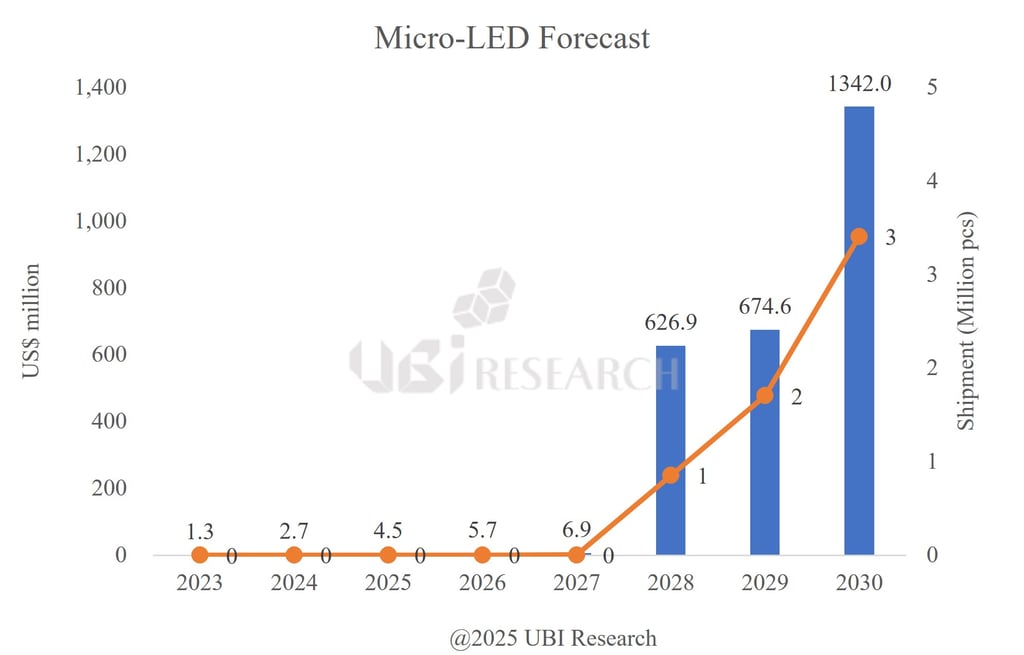
Garmin’s MicroLED Trailblazing Fuels a $1.3B Wearable Revolution – Apple’s 2026 Return Nears
Garmin’s Fenix 8 Pro was unexpectedly the first smartwatch with a MicroLED display, beating TAG Heuer to the honour. AU Optronics (AUO) supplied Garmin’s display panel, marking a milestone for MicroLED adoption in wearables.
Earlier this month, I noted the exceptionally disappointing battery performance of the Garmin Fenix 8 Pro microLED battery. Still, this industry sector has to start somewhere, and Garmin started the ball rolling, so credit where it is due.
UBI Research is now projecting massive growth in this technology, with the MicroLED market expected to reach $1.342 billion by 2030, and its applications to new uses will expand to wearables.

While AUO and Garmin are the first movers, others wait in the wings. Expect TAG Heuer soon to have smaller-volume production, and maybe in a year or two, Apple will ramp up the quantities as production quality matures from AUO, Samsung, and PlayNitride.
We are proud to collaborate with Garmin to launch the first Micro LED smartwatch. This milestone not only showcases the innovation of Micro LED in wearable applications but also marks a significant step toward commercialization. With AUO’s deep expertise in Micro LED R&D and streamlined process integration, we work with our partners to bring differentiated, high-performance wearable solutions to market. [Wei-Lung Liau, CTO of AUO]
MicroLED Market Growth and Projections
UBI Research’s “2025 Micro-LED Display Industry and Technology Trend Report” forecasts that the total microLED market will reach $1.342 billion by 2030, up from the tiny volumes we see today.
After a slow start to the sector, UBI expects the market to grow at over 50% average annual rates from 2028, driven by full-scale commercialisation post-2027 due to improved production efficiency and cost reductions.
Wearables will be a key component of this overall growth. Garmin’s Fenix 8 Pro/AUO is the pioneer, and we will see other companies with significant volumes, like Samsung and PlayNitride, as well as emerging players, like LG Display.
By 2030, the Micro-LED TV market will not only change the competitive landscape of the premium TV market but also affect the profit structure of the forward industry in general, (and it) will create new growth opportunities in the overall value chain (including wearables). [Quote Joohan Kim from UBI Research]
MicroLED – The Game Changer
MicroLED displays deliver higher brightness, a longer lifespan, and better durability than OLEDs. They are also made using inorganic materials and have no burn-in risk. Wide viewing angles, less heat generation, and the potential for lower power consumption are further benefits. But it’s the latter that should be the key to driving growth.

However as we saw with the Fenix 8 Pro’s 1.4-inch MicroLED, battery life suffered and became the headline rather than the benefits of exceptional brightness (up to 4,500 nits), clarity in outdoor conditions, high dynamic contrast, vivid colors, 326 PPI pixel density, superior image quality via AUO’s LTPS active matrix backplane, rapid response time, extended lifespan, and environmental adaptability. A pretty good set of pros – just with that one big, unexpected con.
Yet there is still hope for significant power savings from microLED, as stated by AUO itself.
Micro LED display technology stands out with its high resolution, high brightness, low power consumption, and high reliability features, positioning it as the best solution for next-generation displays. [May 13, 2024 (auo.com)]
(MicroLED offers) higher resolution, increased brightness, lower power consumption, and enhanced reliability. [May 22, 2023 (auo.com)]
One word of caution. Brightness and angled visibility (backed by side-by-side comparisons on dcrainmaker.com and images above) are not unique to microLED—AMOLED can achieve similar performance. However, inorganic microLED should put a stop to the burn-in that inevitably happens with organic AMOLED. In recent months, we have started to see more reports of Garmin AMOLED screens with burn-in.
Drivers of MicroLED Market Expansion to come.
There is generally thought to be a latent demand for high-resolution premium image display products, which has driven investments in production by AU Optronics and others. As production quality increases and failure rates decline, the technology will become more cost-competitive, supporting diversification into wearables, smart glasses, and transparent displays, where the tech benefits will become significantly more compelling.
The key to Micro-LED proliferation is a stable supply of epi wafers… Large-scale MOCVD orders are expected to continue after 2026, and wafer production volume is expected to expand to 10 times the current level by 2030. [UBI Research (Joohan Kim)]
Broader Industry Impact
Garmin led where Apple decided not to risk it. Apple’s 2024 MicroLED cancellation for Watch Ultra was a safe move for the tech giant—probably right in hindsight, considering Garmin’s battery woes. However, analysts predict a revisit to the tech by Apple before 2030 as production quality improves.
Takeaway: Future Outlook and Industry Engagement
We await the next wearable to try their luck with this new tech, perhaps Samsung or one of the Chinese companies will be next?… This (battery life) is a big disappointment for me. Tech is hard to do sometimes. [the5krunner.com (September 5, 2025)]
After passing the cost and quality thresholds, other big wearables players will likely accompany Apple’s return to MicroLED before 2030. UBI expects another year or so of the manufacturers refining production and another 6-12 months of ramping up production before it all takes off in 2028.
What Next?
I expect Garmin to surprise us again with microLED tech in a Varia Vision goggles. Maybe this year.
